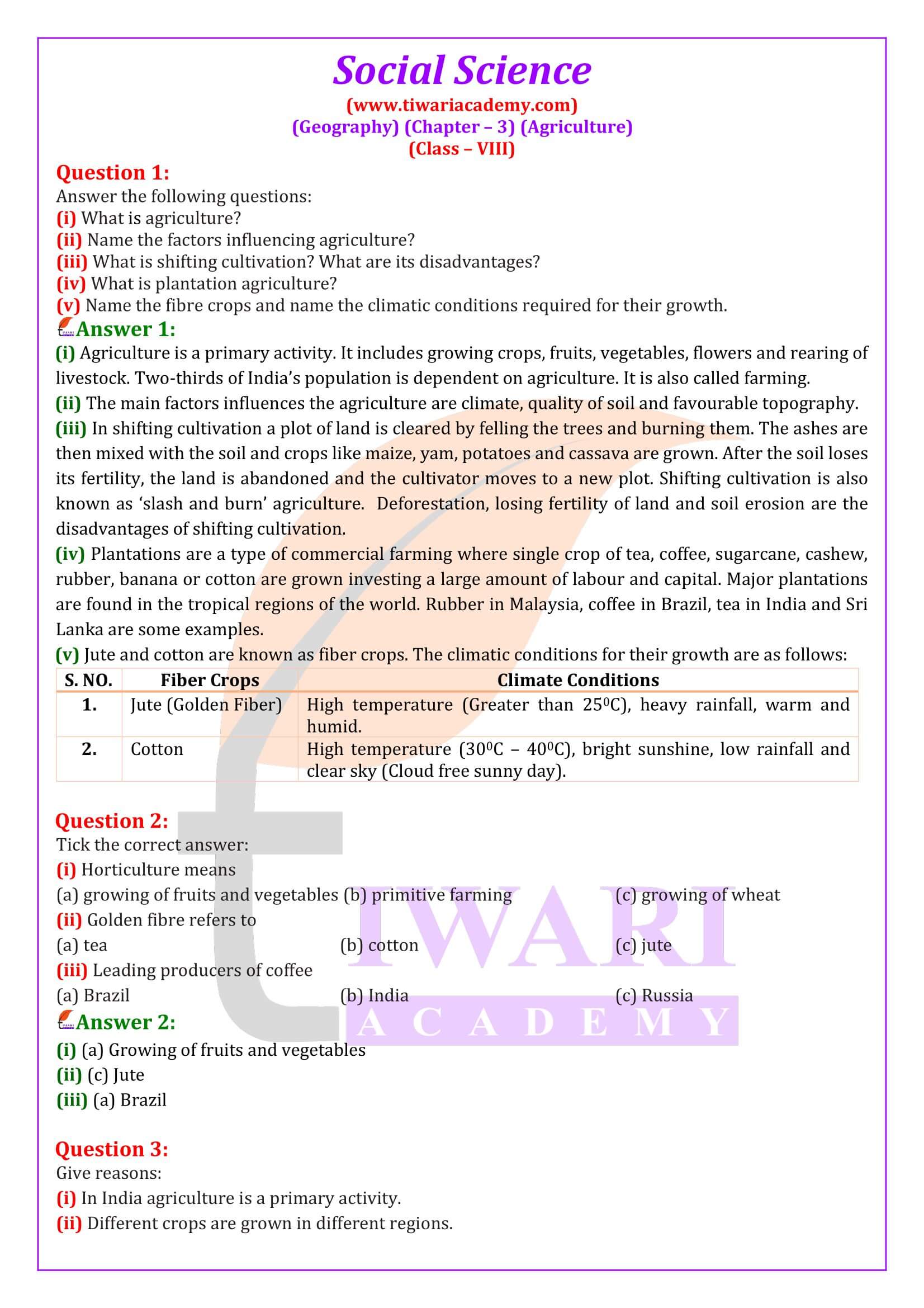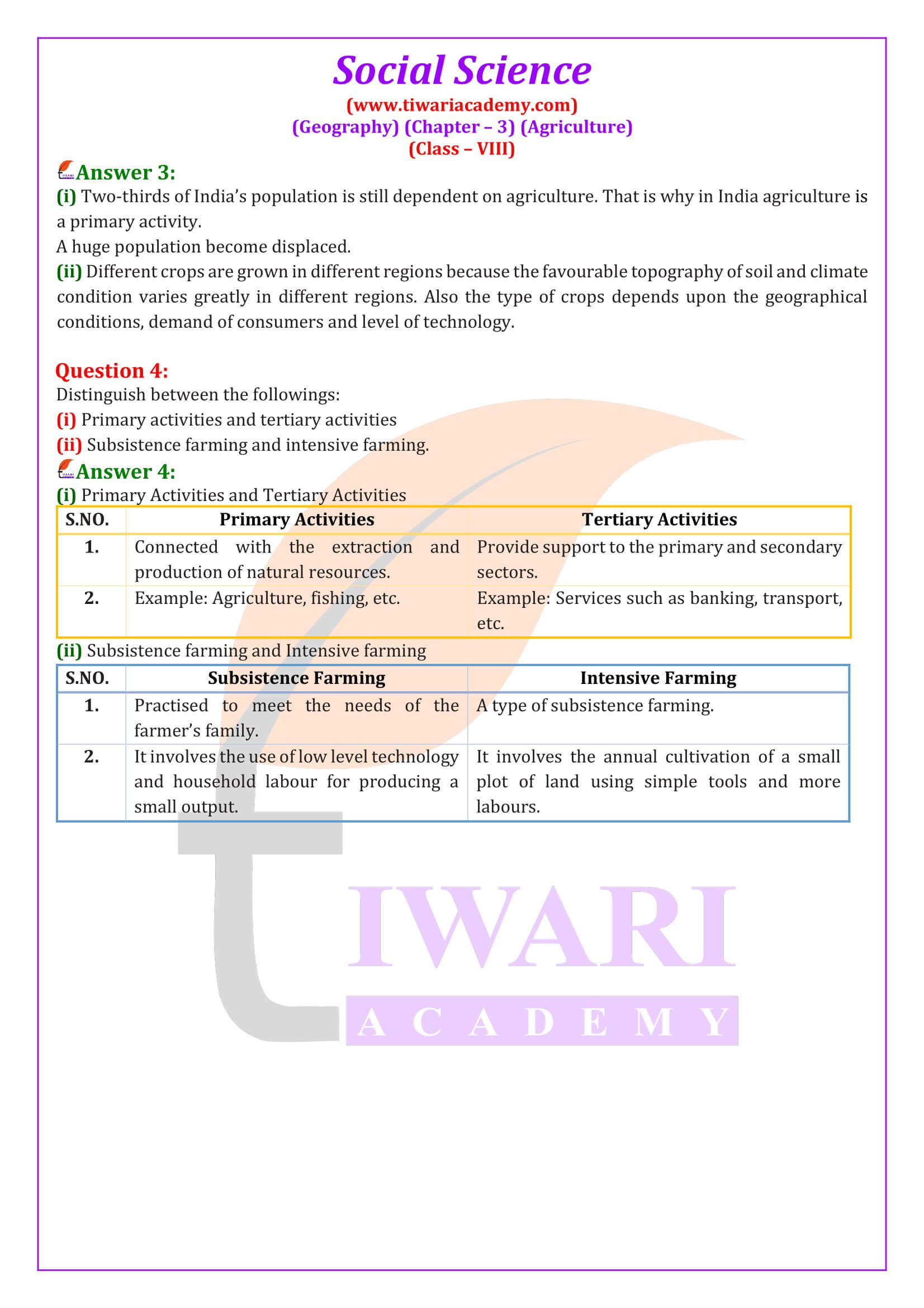NCERT Solutions for Class 8 Social Science Geography Chapter 3 Agriculture in Hindi and English medium modified for academic session 2024-25. Class VIII Geography chapter 3 solution is revised and updated according to rationalised NCERT Books published for 2024-25 exams.
NCERT Solutions for Class 8 Social Science Geography Chapter 3
| Class: 8 | Social Science |
| Subject: | Geography |
| Chapter 3: | Agriculture |
| Academic Session: | 2024-25 |
Class 8 Geography Chapter 3 extra Question
What are the various Types of Farming?
Farming is practised in various ways across the world. Depending upon the geographical conditions, demand of produce, labour and level of technology, farming can be classified into two main types. These are subsistence farming and commercial farming.
What do you understand by Shifting cultivation?
A plot of land is cleared by felling the trees and burning them. The ashes are then mixed with the soil and crops like maize, yam, potatoes and cassava are grown. After the soil loses its fertility, the land is abandoned and the cultivator moves to a new plot. Shifting cultivation is also known as ‘slash and burn’ agriculture. Shifting cultivation is practised in the thickly forested areas of Amazon basin, tropical Africa, parts of Southeast Asia and Northeast India. These are the areas of heavy rainfall and quick regeneration of vegetation.
What do you know about NOMADIC HERDING?
In this type of farming, herdsmen move from place to place with their animals for fodder and water, along defined routes. This type of movement arises in response to climatic constraints and terrain. Sheep, camel, yak and goats are most commonly reared. They provide milk, meat, wool, hides and other products to the herders and their families. Nomadic herding is practised in the semi-arid and arid regions of Sahara, Central Asia and some parts of India, like Rajasthan and Jammu and Kashmir.
What is meant by Mixed farming?
It is practised in Europe, eastern USA, Argentina, southeast Australia, New Zealand and South Africa. In mixed farming the land is used for growing food and fodder crops and rearing livestock.
What are Plantations?
Plantations are a type of commercial farming where single crop of tea, coffee, sugarcane, cashew, rubber, banana or cotton are grown. The produce may be processed on the farm itself or in nearby factories. Major plantations are found in the tropical regions of the world. Rubber in Malaysia, coffee in Brazil, tea in India and Sri Lanka are some examples.
Class 8 Geography Chapter 3 Question Answers
CBSE NCERT Solutions for Class 8 Social Science Geography Chapter 3 Agriculture is given below for session 2024-25. Download NCERT Solutions and Offline Apps to use offline. Study online option is also given, so that everyone can use all the digital contents without downloading.
Important Questions on 8th Geography Chapter 3
What is agriculture?
Agriculture is a primary activity. It includes growing crops, fruits, vegetables, flowers and rearing of livestock. Two-thirds of India’s population is dependent on agriculture. It is also called farming.
Name the factors influencing agriculture?
The main factors influences the agriculture are climate, quality of soil and favourable topography.
What is shifting cultivation? What are its disadvantages?
In shifting cultivation a plot of land is cleared by felling the trees and burning them. The ashes are then mixed with the soil and crops like maize, yam, potatoes and cassava are grown. After the soil loses its fertility, the land is abandoned and the cultivator moves to a new plot. Shifting cultivation is also known as ‘slash and burn’ agriculture. Deforestation, losing fertility of land and soil erosion are the disadvantages of shifting cultivation.
What is plantation agriculture?
Plantations are a type of commercial farming where single crop of tea, coffee, sugarcane, cashew, rubber, banana or cotton are grown investing a large amount of labour and capital. Major plantations are found in the tropical regions of the world. Rubber in Malaysia, coffee in Brazil, tea in India and Sri Lanka are some examples.
Tick the correct answer: Horticulture means (a) growing of fruits and vegetables (b) primitive farming (c) growing of wheat
(a) growing of fruits and vegetables
Tick the correct answer: Golden fibre refers to (a) tea (b) cotton (c) jute
(c) jute
Tick the correct answer: Leading producers of coffee (a) Brazil (b) India (c) Russia
(a) Brazil
Give reasons why in India agriculture is a primary activity?
Two-thirds of India’s population is still dependent on agriculture. That is why in India agriculture is a primary activity. A huge population become displaced.
Why are different crops grown in different regions?
Different crops are grown in different regions because the favorable topography of soil and climate condition varies greatly in different regions. Also the type of crops depends upon the geographical conditions, demand of consumers and level of technology.
Important Notes on 8th Geography Chapter 3
IMPORTANT TERMS ON AGRICULTURE
1. Agriculture: The science and art of cultivation on the soil, raising crops and rearing livestock. It is also called farming.
2. Sericulture: Commercial rearing of silk worms. It may supplement the income of the farmer.
3. Viticulture: Cultivation of grapes.
4. Pisciculture: Breeding of fish in specially constructed tanks and ponds.
5. Horticulture: Growing vegetables, flowers and fruits for commercial use.






